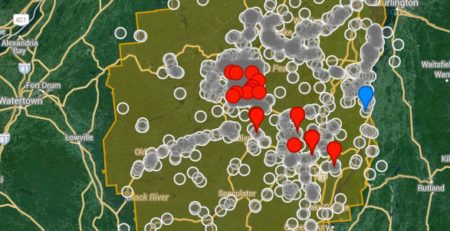10 Tips on Managing Agricultural Land to Protect Ground-Nesting Birds
The Adirondacks is filled with different types of ground-nesting birds: nightjars, loons, bobolinks, robins, Wilson’s warblers, meadowlarks, harriers, and killdeer, to name a few.
Why do these species lay their eggs on the ground rather than in trees, like the other birds we see?
As all these species evolved over time, competition began to grow for nesting sites. While the tops of trees became more occupied, some species found safe and secure spaces on the ground to lay their eggs.
Our civilization has grown tremendously and as a consequence has acquired more and more land to sustain itself. The agricultural sector uses a great deal of land, and its use of heavy machinery puts little birds under a great threat by destroying their nests.
Some species, like the bobolinks and meadowlarks, may breed and nest in the meadows, pastures, or hayfields while other species, like warblers and larks, may nest and forage near crop fields.
Why should any farmer care if they destroy a few nests?
These birds eat the caterpillars, grasshoppers, and other pests that that can infect or kill crops. What can farmers do to manage their land in such a way that will protect ground-nesting birds? Consider these suggestions when managing farm land:
Rotation
- When mowing, leave grass patches where birds are most often found. These unmowed areas will provide shelter and food for the birds.
- Rotate early mowing fields with later mowed fields
- Rotate grassland portions that are to be burned in two to six year rotation, leaving some unburned patches
Equipment
- Flushing bars can help move birds out of the way
- Using mower blades that are 6 inches or more will avoid destroying nests
Nesting Seasons
- Burn grasslands before the birds arrive (early spring).
- Mow grasslands after nesting season is over.
Organize Fields
- Remove brush row/field borders that aren’t needed for erosion control or to protect wetlands to control invasive woody plants using herbicide or burning. This gives the birds more desirable nesting space, so long as the removal is done before or after the season.
- Alternate strips of grass with cultivated crops to provide a habitat for nesting birds, while also preventing runoff and erosion.
Tillage
- Decrease tillage by maintaining 30% of plants and its residue. This will reduce nest destruction and leave outwaste grains and weed seeds that are food for many grassland birds and waterfowl.
Overall proper rotation of mowing and burning grassland patches, upgrading equipment, decreasing tillage, and improving organization of grassland strips and field borders will result in optimal results for protecting ground-nesting birds. Additional information on each of these suggestions are listed below:
Alexa Rosella ‘17
Hamilton College Adirondack Program
Adirondack Research Intern

